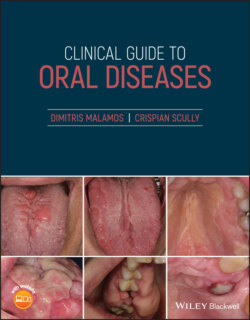Читать книгу Clinical Guide to Oral Diseases - Crispian Scully - Страница 27
Case 2.2
ОглавлениеFigure 2.2a
Figure 2.2b
CO: A 58‐year‐old woman was referred for evaluation of an asymptomatic black spot on the lower alveolar mucosa opposite the right second molar.
HPC: This black lesion was first noticed by her dentist two days ago when the woman visited him to relieve her severe throbbing pain which had arisen from her broken second molar.
HPC: Her medical history was clear from any serious diseases apart from allergic rhinitis which was treated with anti‐histamine tablets. Her recent dental history revealed an extraction of her lower right third molar that had been heavily restored with amalgam.
OE: An isolated, flat black‐gray lesion was seen on the alveolar mucosa covering her previously extracted lower right wisdom tooth. The lesion was asymptomatic, soft in palpation with irregular margins (max dimension of 1.6 cm) and not associated with similar skin and other mucosae lesions or general symptomatology and lymphadenopathy (local or systemic) (Figure 2.2a).The tooth next to the lesion also had an old broken filling with caries underneath causing severe pain. An intra‐oral radiograph revealed a radiopaque material with the healing socket of the extracted molar (Figure 2.2b).
Q1 What is the possible diagnosis?
1 Amalgam tattoo
2 Melanoma
3 Cosmetic tattoo
4 Metal poisoning
5 Pigmented nevus
Answers:
1 Amalgam tattoo is the answer. Amalgam tattoo is the most common exogenous material implanted in the soft tissues of alveolar mucosae, buccal mucosae, gingivae, floor of the mouth, palate, or tongue. It appears as a solitary or multiple, flat black to gray or even blue discrete asymptomatic discoloration, thus causing the patient concern and often being misdiagnosed as melanoma.
2 No
3 No
4 No
5 No
Comments: Localized pigment lesions are common and induced by accumulations of melanine producing cells (macules) benign neoplasmatic cells (nevi) or malignant cell s(melanoma) or even external dyes used for cosmetic tatoos Pigmented nevus has a similar appearance as amalgam tattoo, but has a longer duration with no history of trauma or teeth with heavy amalgam restorations, or even having undergone surgery (apicectomy/extractions). Melanomas have more aggressive clinical appearance, satellite lesions in the skin or oral mucosa, and lymphadenopathy and early distant metastases. Cosmetic tattoos are usually done in visible parts of mouth and skin while poisoning with metals appears as an extensive discoloration of the gingivae and other parts of the human body associated with various toxicity symptoms.
Q2 The diagnosis of this lesion is based mainly on:
1 History
2 Clinical characteristics
3 Radiographic findings
4 Biopsy results
5 Oral photography
Answers:
1 History of previous extraction or renewing of old amalgam fillings by high speed drills or rotary instruments confirms the clinical suspicion of deposition of amalgam metallic particles into adjacent gingivae or other parts of the oral mucosa.
2 The clinical examination together with the previous dental records of old amalgam fillings are useful in the diagnosis of the majority of amalgam tattoos.
3 Intra‐oral X‐rays reveal radiopaque material only if it is adequate in size.
4 Biopsy is the most accurate diagnostic test for amalgam tattoo, as it shows silver impregnation of the reticular fibers of small vessels and nerves that are usually surrounded by chronic inflammatory cells, forming reactive granulomas.
5 No
Comments: A series of photos taken at intervals are very helpful to record changes of other pigmented lesions regarding their size, color, and morphology, while the amalgam photos are rather useless, as this stain does not show any alterations over time.
Q3 Which other oral conditions are related to amalgam fillings apart from amalgam tattoo?
1 Aphthous stomatitis
2 Lichenoid reactions
3 Metallic taste
4 Bullous disorders
5 Teeth discoloration
Answers:
1 No
2 Lichenoid reactions are commonly seen in areas close to amalgam fillings at the result of an allergic reaction of the oral mucosato various metalic components of amalgam.
3 Metallic taste is often reported among patients with very new amalgam fillings or with phobias.
4 No
5 Intrinsic teeth discoloration is common and formed from the deposition of zinc, silver, tin, copper granules and other metallic components within the dental tissues during an amalgam filling preparation (simple or reverse).
Comments: The roughness of an amalgam filling rather the filling per ce is implicated in the development of adjacent traumatic aphthous like ulcerations while bullous disorders are caused by a reaction of circulating auto‐antibodies against various components of the oral mucosa and not against amalgam components.
